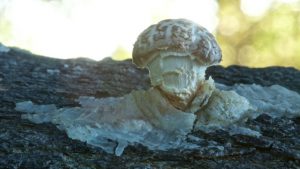
On Thanksgiving weekend a year ago, my family and a few friends set about to grow shiitake mushrooms. We ordered 1000 wooden plugs inoculated with shiitake spores, cut down maple trees and sawed them into four foot lengths with a 4-6 inch diameter, and drilled holes across each log in a diamond pattern. We formed an assembly line, one person drilling the holes, another gently hammering the wooden plugs into the holes and a third person brushing the tops of the plugs with melted beeswax to prevent entry of other fungi into the logs. Then we piled the logs in a square, forming a log cabin shape, in the shade beneath some pine trees.
We were told that we could expect to see shiitakes emerging from the logs in about 8-12 months, and they would continue to appear in spring and fall for the next eight years! Seemed like a good deal for a weekend of work and family fun.
Last week the first mushroom magically appeared. The excitement was contagious. We gathered around this emerging newborn, gleefully celebrating its arrival. My husband photographed it. I check on it daily. Today it measures about an inch in height. I look forward to welcoming its siblings when they are ready, making a feast, and eating them for dinner.
Edible mushrooms are surprisingly nutritious. They are a good source of protein, supplying 200–250 grams of protein per kg of dry matter. They contain a rich assembly of vitamins, with high levels of riboflavin (vitamin B2), niacin, folates, and traces of vitamin C, B1, B12, D and E. Wild mushrooms are the only nonanimal food source that contains vitamin D, so are an important food for vegetarians. They are rich in minerals, containing selenium, potassium, phosphorus, magnesium, calcium, copper, iron, and zinc
All mushrooms have beneficial effects on our immune systems, and can support our immune defence during the fall and winter months. Lentinan, one of the protective substances in shitake mushroooms, improves our resistance against bacterial, fungal, parasitic, and viral infections. The intake of shiitake mushrooms improves the function of our T-helper cells and T-killer cells, increasing our ability to mount an immune response against invaders and cancer cells. Shitake mushrooms inhibit the growth of breast cancer cells and improve the quality of life in women undergoing chemotherapy for breast cancer.
If you are unable to cut down trees and inoculate logs as we did, you can still enjoy growing your own shiitakes by ordering a growing kit. One of the suppliers near me is Wylie Mycologicals. They may not be ready to eat by Thanksgiving, but enjoy them when they arrive!



